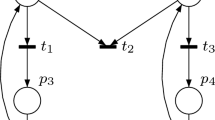Abstract
In this paper we propose an efficient reachability set based Petri net analysis by introducing dynamic priorities which decreases the number of reachable markings in most cases. It is proved that for specific dynamic priority relations certain properties (especially liveness and the existence of home states) do hold if and only if these properties do also hold for the Petri net without priorities. We present an algorithm based on these priority relations additionally exploiting T-invariants thus being able to benefit from the structure of the net.
Preview
Unable to display preview. Download preview PDF.
Similar content being viewed by others
References
F. Bause. On the Analysis of Petri Nets with Static Priorities. Acta Informatica, 33:669–685, 1996.
F. Bause, P. Kritzinger. Stochastic Petri Nets — An Introduction to the Theory. Vieweg, Advanced Studies in Computer Science, 1996.
E. Best and M. Koutny. Petri net semantics of priority systems. Theoretical Computer Science, 96:175–215, 1992.
E. Best and K. Voss. Free choice systems have home states. Acta Informatica, 21:89–100, 1984.
S. Caselli, G. Conte and P. Marenzoni. Parallel state space exploration for GSPN models. In Application and Theory of Petri Nets, LNCS 935, pages 181–201, Springer-Verlag, 1995.
J. Desel and J. Esparza. Free Choice Petri Nets. Cambridge University Press, 1995.
F. Feldbrugge. Petri Net Tool Overview 1992. in Advances in Petri Nets, Springer-Verlag, pages 169–209, 1993.
P. Godefroid. Partial-Order Methods for the Verification of Concurrent Systems. Ph.D. thesis, Univerite de Liege, 1995.
R. Janicki. A formal semantics for concurrent systems with a priority relation. Acta Informatica, 24:33–55, 1987.
P. Kemper. Reachability analysis based on structured representations. 17th Int. Conf. Application and Theory of Petri nets, 1996.
M. Koutny. Modelling systems with dynamic priorities. Advances in Petri Nets, pages 251–266, Springer-Verlag, 1992.
J.L. Peterson. Petri Net Theory and the Modelling of Systems. Prentice-Hall, 1981.
K. Varpaaniemi, J. Halme, K. Hiekkanen and T. Pyssysalo. PROD reference manual. Technical Reports Series B, No 13, Helsinki University of Technology, Digital Systems Laboratory, 1995.
M. Rauhamaa. A comparative study of methods for efficient reachability analysis. Helsinki Univerity of Technology, Digital Systems Lab., Report A14, Sept. 1990.
E. Teruel, P. Chrzastowski-Wachtel, J.M. Colom and M. Silva. On Weighted T-Systems. In Proceedings of the 13th International Conference on Application and Theory of Petri Nets, Sheffield (UK), 1992.
E. Teruel and M. Silva. Liveness and home states in equal conflict systems. In Proceedings of the 14th International Conference on Application and Theory of Petri Nets, Chicago (USA), pages 415–432, 1993.
M. Tiusanen. Symbolic, Symmetry, and Stubborn Set Searches In Proceedings of the 15th European Workshop on Application and Theory of Petri Nets, Zaragoza (Spain), pages 511–530, 1994.
A. Valmari. Error Detection by Reduced Reachability Graph Generation. In Proceedings of the 9th European Workshop on Application and Theory of Petri Nets, Venice (Italy), pages 95–112, 1988.
A. Valmari. Stubborn sets for reduced state space generation. In Advances in Petri Nets, Springer-Verlag, 1990.
A. Valmari. State of the Art Report: Stubborn Sets. Petri Net Newletters 46, pages 6–14, 1994.
K. Varpaaniemi. On Combining the Stubborn Set Method with the Sleep Set Method. In Proceedings of the 15th European Workshop on Application and Theory of Petri Nets, Zaragoza (Spain), pages 548–567, 1994.
Author information
Authors and Affiliations
Editor information
Rights and permissions
Copyright information
© 1997 Springer-Verlag Berlin Heidelberg
About this paper
Cite this paper
Bause, F. (1997). Analysis of Petri nets with a dynamic priority method. In: Azéma, P., Balbo, G. (eds) Application and Theory of Petri Nets 1997. ICATPN 1997. Lecture Notes in Computer Science, vol 1248. Springer, Berlin, Heidelberg. https://doi.org/10.1007/3-540-63139-9_38
Download citation
DOI: https://doi.org/10.1007/3-540-63139-9_38
Published:
Publisher Name: Springer, Berlin, Heidelberg
Print ISBN: 978-3-540-63139-2
Online ISBN: 978-3-540-69187-7
eBook Packages: Springer Book Archive




